Chapter: Compilers : Principles, Techniques, & Tools : Code Generation
Optimization of Basic Blocks
Optimization of Basic Blocks
1 The DAG Representation of Basic Blocks
2 Finding Local Common Subexpressions
3 Dead Code Elimination
4 The Use of Algebraic Identities
5 Representation of Array References
6 Pointer Assignments and Procedure Calls
7 Reassembling Basic Blocks From DAG's
8 Exercises for Section 8.5
We can often obtain a substantial
improvement in the running time of code merely by performing local optimization within each basic
block by itself. More thorough global
optimization, which looks at how information flows among the basic blocks of a
program, is covered in later chapters, starting with Chapter 9. It is a complex
subject, with many different techniques to consider.
1. The DAG Representation of
Basic Blocks
Many important techniques for
local optimization begin by transforming a basic block into a DAG (directed
acyclic graph). In Section 6.1.1, we introduced the DAG as a representation for
single expressions. The idea extends naturally to the collection of expressions
that are created within one basic block. We construct a DAG for a basic blockas
follows:
1. There is a node in the DAG for each of the initial values of the
variables appearing in the basic block.
2. There is
a node N associated with
each statement s
within the block. The children of
N are those nodes corresponding to statements that are the last definitions,
prior to s, of the operands used by s.
3. Node N is labeled by the operator applied at s,
and also attached to N is the list of variables for which it is the last definition
within the block.
4. Certain nodes
are designated output nodes.
These are the nodes whose variables
are live on
exit from the block; that
is, their values may be used later, in another block of the
flow graph. Calculation of these "live variables" is a matter for
global flow analysis, discussed in Section 9.2.5.
The DAG representation of a basic
block lets us perform several code-improving transformations on the code
represented by the block.
We can eliminate local common subexpressions, that is,
instructions that compute a value that has already been computed.
We can eliminate dead code, that is, instructions that
compute a value that is never used.
We can reorder statements that do
not depend on one another; such reordering may reduce the time a temporary
value needs to be preserved in a register.
We can apply algebraic laws to reorder operands of three-address
instruc-tions, and sometimes thereby simplify the computation.
2. Finding Local Common
Subexpressions
Common subexpressions can be
detected by noticing, as a new node M
is about to be added, whether there is an existing node N with the same children, in the same order, and with the same
operator. If so, TV computes the same value as M and may be used in its place. This technique was introduced as
the "value-number" method of detecting common subexpressions in
Section 6.1.1.
Example 8
. 1 0 : A DAG for the block
a
= b +
c
b = a - d c = b + c
d = a – d
is shown in Fig. 8.12. When we
construct the node for the third statement c = b + c, we know that the use of b
in b + c refers to the node of Fig. 8.12 labeled -, because that is the most recent definition of
b. Thus, we do not confuse the values computed at statements one and three.
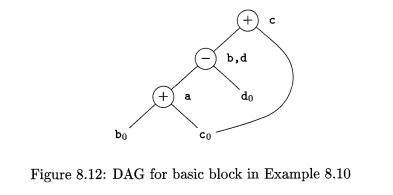
However, the node corresponding to the fourth
statement d = a - d has the operator - and the nodes with attached variables a and do
as children. Since the operator and the children are the same as those for the
node corresponding to statement two, we do not create this node, but add d to
the list of definitions for the node labeled —. •
It might appear that, since there are only three nonleaf nodes in the
DAG of Fig. 8.12, the basic block in Example 8.10 can be replaced by a block
with only three statements. In fact, if b is not live on exit from the block,
then we do not need to compute that variable, and can use d to receive the
value represented by the node labeled —. in Fig. 8.12. The block then becomes
However, if both b and d are live on exit, then a
fourth statement must be used to copy the value from one to the other.1
E x a m p l e 8.11: When we
look for common subexpressions, we really are look-ing for expressions that are
guaranteed to compute the same value, no matter how that value is computed.
Thus, the DAG method will miss the fact that the expression computed by the
first and fourth statements in the sequence
a = b + c;
b = b - d
c = c + d
e = b + c
is the same, namely bo 4- en. That is, even though b and c both change
between the first and last statements, their sum remains the same, because b + c = (b - d) + (c + d). The DAG for this sequence is shown in Fig. 8.13,
but does not exhibit any common
subexpressions. However, algebraic identities applied to the DAG, as discussed
in Section 8.5.4, may expose the equivalence.
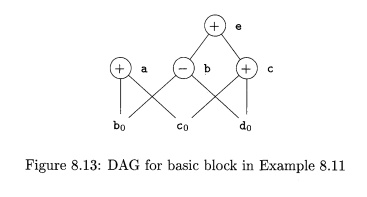
3. Dead Code Elimination
The operation on DAG's that
corresponds to dead-code elimination can be im-plemented as follows. We delete
from a DAG any root (node with no ancestors) that has no live variables attached.
Repeated application of this transformation will remove all nodes from the DAG
that correspond to dead code.
Example 8.12: If, in
Fig. 8.13, a and b are live but c and e are not, we can immediately remove the root
labeled e. Then, the node labeled c becomes a root and can be removed. The
roots labeled a and b remain, since they each have live variables attached. •
4. The Use of Algebraic
Identities
Algebraic identities represent another important class of optimizations
on basic blocks. For example, we may apply arithmetic identities, such as

to eliminate computations from a basic block.
Another class of algebraic optimizations includes local reduction in strength, that is,
replacing a more expensive operator by a cheaper one as in:

A third class of related optimizations is constant folding. Here we evaluate
constant expressions at compile time and replace the constant expressions by
their values.2 Thus the expression 2 * 3 . 1 4 would be replaced by 6 . 2 8 . Many
constant expressions arise in practice because of the frequent use of symbolic
constants in programs.
The DAG-construction process can help us apply
these and other more general algebraic transformations such as commutativity
and associativity. For example, suppose the language reference manual specifies
that * is commutative; that is, x*y =
y*x. Before we create a new node labeled * with left child M and right child N, we always check whether such a node already exists. However,
because * is commutative, we should then check for a node having operator *,
left child N, and right child M.
The relational operators such as < and —
sometimes generate unexpected common subexpressions. For example, the condition
x > y can also be tested by
subtracting the arguments and performing a test on the condition code set by
the subtraction.3 Thus, only one node of the DAG may need to be generated for x — y and x > y.
Associative laws might also be applicable to expose common
subexpressions. For example, if the source code has the assignments

the following intermediate code might be generated:
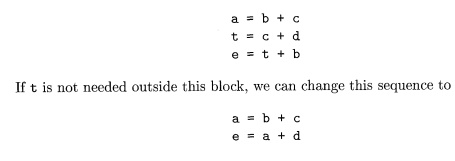
using both the associativity and commutativity of
+.
The compiler writer should examine the language reference manual care-fully
to determine what rearrangements of computations are permitted, since (because
of possible overflows or underflows) computer arithmetic does not al-ways obey
the algebraic identities of mathematics. For example, the Fortran standard
states that a compiler may evaluate any mathematically equivalent
expression, provided that the integrity
of parentheses is not violated. Thus, a
compiler may evaluate x * y — x * z a,s x * (y - z), but it may not evaluate a
+ (6 — c) as (a + b) — c. A Fortran compiler must therefore keep track of where
parentheses were present in the source language expressions if it is to
optimize programs in accordance with the language definition.
5. Representation of Array
References
At first glance, it might appear that the array-indexing instructions
can be treated like any other operator. Consider for instance the sequence of
three-address statements:

If we think of a [ i ] as an
operation involving a and i, similar to
a + i, then it might appear as if the two uses of a [ i ] were a common
subexpression. In that case, we might be tempted to "optimize" by
replacing the third instruction z = a [ i ]
by the simpler z = x. However, since j could equal i, the middle statement may in
fact change the value of a [ i ] ; thus, it is not legal to make this
change.
The proper way to represent array accesses in a DAG is as follows.
1. An assignment from an array, like x
= a [ i ] , is represented by creating a node with operator =[] and two
children representing the initial value of the array, a0 in this case, and the index i. Variable x becomes a label of this new
node.
2. An assignment to an array, like a [ j ] = y, is represented by a new node with operator
[]= and three children representing a 0 , j and y. There is no variable
labeling this node. What is different is that the creation of this node
kills all currently constructed nodes
whose value depends on a 0 . A node that has been killed cannot receive any more labels; that is,
it cannot become a common subexpression.
Example 8
. 1 3 : The DAG for the basic block
x = a [ i ]
a [ j ] = y
z = a [ i ]
is shown in Fig- 8.14. The node N for x is created
first, but when the node labeled [ ] = is created, N is killed. Thus, when the node for z is created, it
cannot be identified with N, and a new node with the same operands a0 and i0
must be created instead.
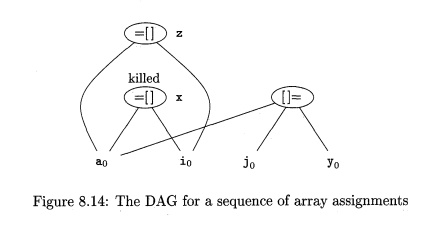
Example 8 . 14: Sometimes, a node must be killed
even though none of its children have an array like a0 in Example 8.13 as
attached variable. Likewise, a node can kill if it has a descendant that is an
array, even though none of its children are array nodes. For instance, consider
the three-address code
b = 12 + a
x = b [ i ]
b [ j ] = y
What is happening here is that, for efficiency
reasons, b has been defined to be a position in an array a. For example, if the
elements of a are four bytes long, then b represents the fourth element of a.
If j and i represent the same value, then b [ i ] and b [ j ] represent the
same location. Therefore it is important to have the third instruction, b [ j ]
= y, kill the node with x as its attached variable. However, as we see in Fig.
8.15, both the killed node and the node that does the killing have cio as a
grandchild, not as a child.
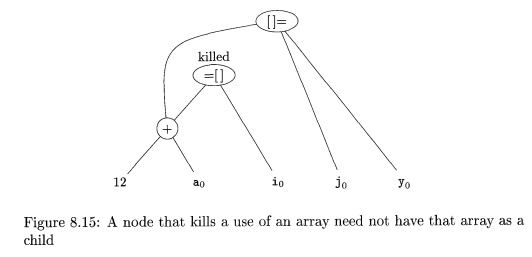
6. Pointer Assignments and
Procedure Calls
When we assign indirectly through a pointer, as in
the assignments
x = *p
*q = y
we do not know what p or q point to. In effect, x =
*p is a use of every variable whatsoever, and *q = y is a possible assignment
to every variable. As a consequence, the operator =* must take all nodes that
are currently associated with identifiers as arguments, which is relevant for
dead-code elimination. More importantly, the *= operator kills all other nodes
so far constructed in the DAG.
There are global pointer analyses
one could perform that might limit the set of variables a pointer could
reference at a given place in the code. Even local analysis could restrict the
scope of a pointer. For instance, in the sequence
p = &x
*p = y
we know that x, and no other variable, is given the
value of y, so we don't need to kill any node but the node to which x was
attached.
Procedure calls behave much like
assignments through pointers. In the absence of global data-flow information,
we must assume that a procedure uses and changes any data to which it has
access. Thus, if variable x is in the scope of a procedure P, a call to P both uses the node with attached
variable x and kills that node.
7. Reassembling Basic Blocks From
DAG's
After we perform whatever
optimizations are possible while constructing the DAG or by manipulating the
DAG once constructed, we may reconstitute the three-address code for the basic
block from which we built the DAG. For each
node that has one or more attached variables, we construct a
three-address statement that computes the value of one of those variables. We
prefer to compute the result into a variable that is live on exit from the
block. However, if we do not have global live-variable information to work
from, we need to assume that every variable of the program (but not temporaries
that are generated by the compiler to process expressions) is live on exit from
the block.
If the node has more than one
live variable attached, then we have to in-troduce copy statements to give the
correct value to each of those variables. Sometimes, global optimization can
eliminate those copies, if we can arrange to use one of two variables in place
of the other.
Example 8 . 1 5 : Recall the DAG of Fig. 8.12. In the discussion following Example 8.10, we decided that if b is
not live on exit from the block, then the three statements
a = b + c
d = a - d
c = d + c
suffice to reconstruct the basic
block. The third instruction, c = d
+ c, must use d as an operand rather
than b, because the optimized block never computes b.
If both b and d are live on exit, or if we are not sure whether or not
they are live on exit, then we need to compute b as well as d. We can do so
with the sequence
a = b + c
d = a - d
b = d
c = d + c
This basic block is still more efficient than the
original. Although the number of instructions is the same, we have replaced a
subtraction by a copy, which tends to be less expensive on most machines.
Further, it may be that by doing a global analysis, we can eliminate the use of
this computation of b outside the block by replacing it by uses of d. In that
case, we can come back to this basic block and eliminate b = d later.
Intuitively, we can eliminate this copy if wherever this value of b is used, d
is still holding the same value. That situation may or may not be true,
depending on how the program recomputes d. •
When reconstructing the basic block from a DAG, we
not only need to worry about what variables are used to hold the values of the
DAG's nodes, but we also need to worry about the order in which we list the
instructions computing the values of the various nodes. The rules to remember
are
1. The order of instructions must respect the order of nodes in the DAG.
That is, we cannot compute a node's value until we have computed a value for
each of its children.
2. Assignments
to an array must follow all previous assignments to, or eval-uations from, the
same array, according to the order of these instructions in the original basic
block.
Evaluations of array elements
must follow any previous (according to the original block) assignments to the
same array. The only permutation allowed is that two evaluations from the same
array may be done in either order, as long as neither crosses over an
assignment to that array.
Any use of a variable must follow
all previous (according to the original block) procedure calls or indirect
assignments through a pointer.
Any procedure call or indirect
assignment through a pointer must follow all previous (according to the
original block) evaluations of any variable.
That is, when reordering code, no statement may
cross a procedure call or assignment through a pointer, and uses of the same
array may cross each other only if both are array accesses, but not assignments
to elements of the array.
8. Exercises for Section 8.5
Exercise
8 . 5 . 1 :
Construct the DAG for the basic block
d = b * c
e = a + b
b = b * c
a = e - d
Exercise
8 . 5 . 2: Simplify the three-address code of Exercise
8.5.1, assuming
Only a is
live on exit from the block.
a, b, and c
are live on exit from the block.
Exercise
8 . 5 . 3 : Construct the basic block for
the code in block B6 of Fig. 8.9.
Do not forget to include the comparison i < 10.
Exercise
8 . 5 . 4 : Construct the basic block for the
code in block B3 of Fig. 8.9.
Exercise
8 . 5 . 5 : Extend Algorithm 8.7 to process
three-statements of the form
a) a [ i ]
= b
b) a = b [
i ]
a = *b
*a = b
Exercise
8 . 5 . 6 : Construct the DAG for the basic block
a [ i ] = b
*p = c
= a [ j ]
= *p
*p = a [ i ]
on the assumption that
p can point anywhere.
p can point only to b or d.
Exercise 8 . 5 . 7 : If a pointer or array
expression, such as a [ i ] or *p is assigned and then used, without the
possibility of being changed in the interim, we can take advantage of the
situation to simplify the DAG. For example, in the code of Exercise 8.5.6,
since p is not assigned between the second and fourth statements, the statement
e = *p can be replaced by e = c, regardless of what p points to. Revise the
DAG-construction algorithm to take advantage of such situations, and apply your algorithm to the code of
Example 8.5.6.
Exercise 8 . 5 . 8 : Suppose a basic block is formed from the C
assignment statements
x = a
+ b + c
+ d + e
+ f;
y = a
+ c + e;
Give the three-address statements
(only one addition per statement) for this block.
Use the associative and
commutative laws to modify the block to use the fewest possible number of
instructions, assuming both x and y are live on exit from the block.
Related Topics